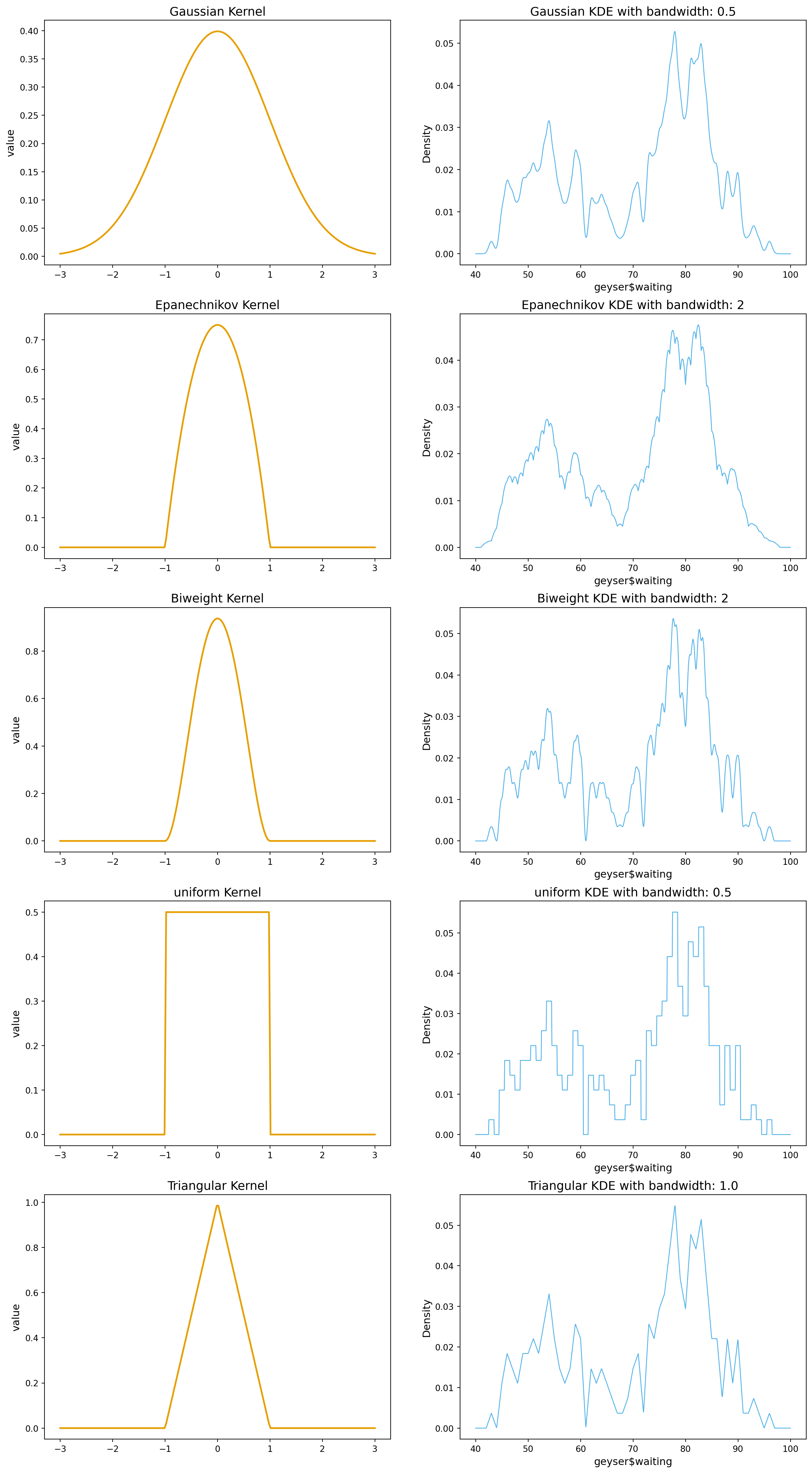import numpy as np
import matplotlib.pyplot as plt
import seaborn as sns
from sklearn.neighbors import KernelDensity
# okabe-ito color
color = [
"#E69F00",
"#56B4E9",
"#009E73",
"#F0E442",
"#0072B2",
"#D55E00",
"#CC79A7",
"#000000",
]
# Gaussian kernel function
def gaussian_kernel(u):
return (1 / np.sqrt(2 * np.pi)) * np.exp(-0.5 * u**2)
def epanechnikov_kernel(u):
const = 3 / 4
return const * (1 - u**2) * (np.abs(u) <= 1).astype(float)
def biweight_kernel(u):
const = 15 / 16
return const * ((1 - u**2) ** 2) * (np.abs(u) <= 1).astype(float)
def uniform_kernel(u):
return 0.5 * (np.abs(u) <= 1).astype(float)
def triangular_kernel(u):
return (1 - np.abs(u)) * (np.abs(u) <= 1).astype(float)
# KDE
def kde(x, data, bandwidth, kernel_func):
n = len(data)
return (1 / (n * bandwidth)) * np.sum(kernel_func((x - data) / bandwidth))
# Load Old Faithful dataset (from seaborn)
data = sns.load_dataset("geyser") # modern version of faithful dataset
waiting = data["waiting"].dropna().values
# Plot kernels
u = np.linspace(-3, 3, 200)
x_plot = np.linspace(40, 100, 1000)
fig, axes = plt.subplots(5, 2, figsize=(16, 6 * 5))
# gaussian
kde_vals = list(map(lambda x: kde(x, waiting, 0.5, gaussian_kernel), x_plot))
axes[0, 0].plot(u, gaussian_kernel(u), color[0], lw=2)
axes[0, 0].set_ylabel("value", fontsize=12)
axes[0, 0].set_title("Gaussian Kernel", fontsize=14)
axes[0, 1].plot(x_plot, kde_vals, color[1], lw=1)
axes[0, 1].set_ylabel("Density", fontsize=12)
axes[0, 1].set_xlabel("geyser$waiting", fontsize=12)
axes[0, 1].set_title("Gaussian KDE with bandwidth: 0.5", fontsize=14)
# epanechnikov
kde_vals = list(map(lambda x: kde(x, waiting, 2, epanechnikov_kernel), x_plot))
axes[1, 0].plot(u, epanechnikov_kernel(u), color[0], lw=2)
axes[1, 0].set_ylabel("value", fontsize=12)
axes[1, 0].set_title("Epanechnikov Kernel", fontsize=14)
axes[1, 1].plot(x_plot, kde_vals, color[1], lw=1)
axes[1, 1].set_ylabel("Density", fontsize=12)
axes[1, 1].set_xlabel("geyser$waiting", fontsize=12)
axes[1, 1].set_title("Epanechnikov KDE with bandwidth: 2", fontsize=14)
# Biweight
kde_vals = list(map(lambda x: kde(x, waiting, 1, biweight_kernel), x_plot))
axes[2, 0].plot(u, biweight_kernel(u), color[0], lw=2)
axes[2, 0].set_ylabel("value", fontsize=12)
axes[2, 0].set_title("Biweight Kernel", fontsize=14)
axes[2, 1].plot(x_plot, kde_vals, color[1], lw=1)
axes[2, 1].set_ylabel("Density", fontsize=12)
axes[2, 1].set_xlabel("geyser$waiting", fontsize=12)
axes[2, 1].set_title("Biweight KDE with bandwidth: 2", fontsize=14)
# Uniform
kde_vals = list(map(lambda x: kde(x, waiting, 0.5, uniform_kernel), x_plot))
axes[3, 0].plot(u, uniform_kernel(u), color[0], lw=2)
axes[3, 0].set_ylabel("value", fontsize=12)
axes[3, 0].set_title("uniform Kernel", fontsize=14)
axes[3, 1].plot(x_plot, kde_vals, color[1], lw=1)
axes[3, 1].set_ylabel("Density", fontsize=12)
axes[3, 1].set_xlabel("geyser$waiting", fontsize=12)
axes[3, 1].set_title("uniform KDE with bandwidth: 0.5", fontsize=14)
# Triangular
kde_vals = list(map(lambda x: kde(x, waiting, 1.0, triangular_kernel), x_plot))
axes[4, 0].plot(u, triangular_kernel(u), color[0], lw=2)
axes[4, 0].set_ylabel("value", fontsize=12)
axes[4, 0].set_title("Triangular Kernel", fontsize=14)
axes[4, 1].plot(x_plot, kde_vals, color[1], lw=1)
axes[4, 1].set_ylabel("Density", fontsize=12)
axes[4, 1].set_xlabel("geyser$waiting", fontsize=12)
axes[4, 1].set_title("Triangular KDE with bandwidth: 1.0", fontsize=14)
plt.show()
